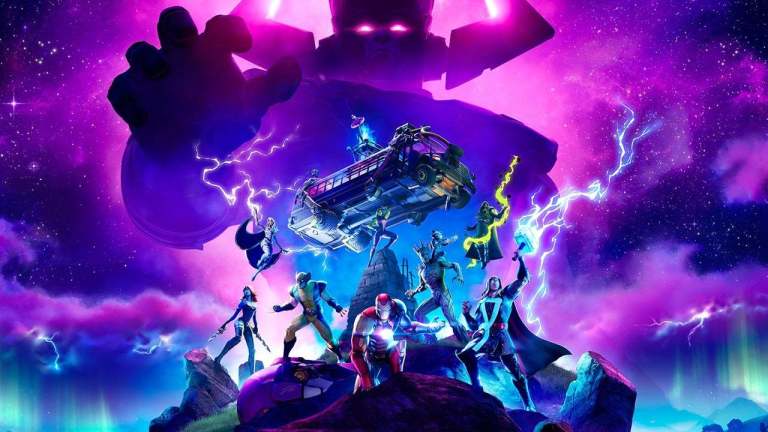How Fortnite Became Gaming’s Great Shameless Marketing Tool
Fortnite isn't dead. It lives on as a highly successful marketing platform for Star Wars, Marvel, and other big brands.

“Fortnite is dead” felt like an increasingly popular sentiment in 2020. You certainly didn’t have to look too hard to find comments from gamers who felt that it was the end of an era for a game so popular that it was prominently featured in the highest-grossing movie of all-time.
But in recent months, it felt like the game had fallen off the cultural radar. Whenever you looked at Twitch, it seemed like most of the service’s most popular streamers had moved on to Call of Duty: Warzone, Valorant, and a legion of viral games like Fall Guys, Among Us, and Genshin Impact. Fortnite rarely felt like the game to watch anymore.
Even as the spread of Covid-19 forced most people into quarantine and boosted the success of games like Animal Crossing: New Horizons, Fortnite struggled to work its way back into the narrative the same way that it had in the past. The closest it got to controlling the conversation this year was as the subject of Epic’s war with Apple, as fans and outlets speculated about the impact this high-profile breakup would have on the game’s present and future.
Yet, Fortnite‘s most recent in-game event broke records once again as 15.3 million concurrent players joined the end of season 4 battle against Galactus and over 3.4 million people watched the event play out on Twitch and YouTube. That may sound like an unusual spike in players, but the truth of the matter is that the numbers have always been on Fortnite‘s side.
While Epic doesn’t typically reveal Fortnite‘s official user count or revenue figures, scrapes of the data that is available paint a compelling picture of the game’s continued success. Estimates made in August suggest that over 20 million people still play Fortnite daily. The game also made over $1.8 billion in 2019, which is a drop from the game’s $2.4 billion in revenue in 2018 but is still better than the vast majority of free-to-play games. Meanwhile, Fortnite‘s viewership numbers may have dipped slightly over time, but the game’s “Black Hole” event is still the most-viewed video game event in history while the in-game Travis Scott concert attracted more players than the game’s very first concert.
Fortnite‘s absurd event numbers reveal a key point. The reason why some people seem to think that Fortnite is failing is that they’re still trying to measure the title’s success like it’s any other video game. Instead, they should recognize Fortnite for what it has become: the greatest marketing tool in video game history.
Before Fortnite, ads in video games were typically treated with as much reverence as loot boxes, whether it was the Skittles-inspired Darkened Skye or Pepsiman, which was designed to sell cola. The most these games could hope for in the late ’90s and early ’00s was that word of mouth of how cringeworthy they were would help them sell their intended products. But oddly enough, these games were the precursors for the type of viral marketing that would one day turn Fortnite into a powerhouse.
When Fortnite‘s battle royale mode was released in 2017, it was essentially released as a companion piece to the less successful Fortnite: Save the World base-building shooter, which was originally the game’s main component. To some, the battle royale mode was Epic’s desperate attempt to quickly capitalize on the success of PUBG, the PC game largely credited for popularizing this particular subgenre. However, a little time with the game revealed the truth.
Fortnite: Battle Royale arrived as a well-made, easy-to-play title while PUBG was a rough early access game loaded with bugs. Most importantly, Fortnite was a light, family-friendly alternative packed with raw silliness while PUBG was a “realistic” military-based shooter. In many ways, Fortnite‘s zany art style and gameplay were simply more appealing to general audiences.
The mode’s more casual silliness quickly became its calling card. Take the battle royale mode’s dancing emotes. While some have (perhaps rightfully) called out Epic for stealing certain dance moves, there’s no question that Fortnite popularized many of these moves on such a grand scale that the game became associated with them more than their creators. If you can stomach watching it, this video of Ninja “flossing” in Times Square during the NYC 2018 New Year’s Eve party really captures how Fortnite shamelessly forced its way into the public conscious:
But for all of its success as a video game, Fortnite had yet to evolve into its final form. In 2018, Fortnite kicked off its first major in-game events as well as its first significant promotional tie-in: a campaign for the FIFA World Cup. While it makes sense that a live service game developer would want to capitalize off of a global event like the World Cup, in this instance, the relationship was mutually beneficial. Soccer players across the world were already incorporating Fortnite references into their celebrations, and FIFA enjoyed the viral moments that came with popular footballers like Antoine Griezmann performing the “Take the L” dance after scoring a goal. FIFA and Fortnite seemed to be a natural fit.
“Natural” also perfectly describes Fortnite‘s then-shocking 2018 in-game event which allowed players to hunt down the Infinity Stones from the Avengers movies and become Thanos. Prior to that event, it would have been difficult to name a developer savvy enough to not only quickly capitalize on the release of the year’s hottest movie (Avengers: Infinity War) but to build the kind of platform where such a collaboration felt exciting rather than just another cheap marketing ploy.
But that’s the thing about Fortnite. It’s flexible enough that it can incorporate characters and ideas from just about any universe without feeling like the “core” or “spirit” of the game is being compromised in some way. Fortnite was practically built on a foundation of silliness. In the age of memes, shameless streamers, and yes, the growth of the battle royale concept, Fortnite became this pop culture vessel that elevated, and sometimes re-shaped, nearly everything it touched.
There’s perhaps no greater example of Fortnite‘s marketing power than the case of Keanu Reeves and John Wick. One of Fortnite’s most popular early skins was a character called The Reaper who bore a striking resemblance to John Wick. The resemblance was so striking, in fact, that Reeves helped the team officially add John Wick to the game after he said kids were coming up to him in the street and calling him “Fortnite guy.” It’s another case of Fortnite not only being able to juggle the lead of a Rated R action movie as easily as The Avengers and soccer stars but the game’s ability to weirdly appropriate pieces of pop culture and recontextualize them for an entirely different (often younger) audience.
To the studio’s credit, Epic treats these special events as something truly special. Travis Scott didn’t just put on a concert, he became a towering behemoth that players orbited as he tore through time and space. Fortnite didn’t screen a scene from Star Wars: The Rise of Skywalker — Epic designed an elaborate sequence that concluded with the addition of lightsabers to the game.
And that’s where we find Fortnite at the end of 2020 as players finish their battle against Galactus (for now) and don skins from The Mandalorian. Epic has built a marketing platform that is so effective and in-tune with the digital age that it has inspired marketing analysts to study just how the studio did it. In those studies, you hear words like “freemium,” “engagement,” and “community.” Those elements are certainly part of Fortnite‘s success in this arena.
Yet, when trying to wrap your head around just how Epic built the most effective billboard of the digital age, consider the possibility that Epic’s real accomplishment is making Fortnite a fun and wildly engaging game first before it tried to cash-in as a viral marketing tool for other brands. Brands wouldn’t be talking to Epic if Fortnite didn’t have such a strong foundation in the first place.
Fortnite: Battle Royale was built on the idea that Fortnite needed to adapt or die. It’s that philosophy that has allowed the game to become the kind of digital marketing platform that may never be replicated.
